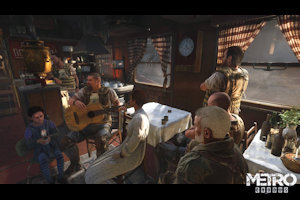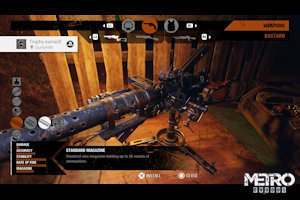Solo Gamer Review: Metro Exodus
Taking cues from Metro 2035, the third novel in Dmitry Glukhovsky's internationally celebrated Metro series, 4A Games have taken the video game franchise in a bold, new direction: outside. Metro Exodus not only changes up the setting, though. It also takes what was once a linear corridor shooter with survival horror overtones and gives it a more open world aesthetic. Does this shake-up to the formula yield good results and take Artyom to wondrous new frontiers, or has the magic of the franchise been lost?
STORY
 | | The characters grow on you until they feel like family |
If you read my review of Metro 2035, you'll know I'm not the biggest fan of where Glukhovsky decided to take the character of Artyom. Metro Exodus, in roughly the first hour or two of its story, offers a very brief, Cliffs Notes-style runthrough of 2035's basic ideas--without turning Artyom into an insufferable jerk or ruining his relationship with his wife (named Anna in the video games)--before completely detaching from it and charting its own course through Glukhovsky's universe. In the game's version of events, Artyom and his wife leave the Metro with a crew of Spartans, including the Order's leader (and Artyom's father-in-law), Colonel Miller, in a train called the Aurora, delighted to discover that the world isn't as dead and irradiated as they thought. At first, their mission is to meet up with the "Ark," a secret headquarters of what is left of the Russian government, but things there are predictably not what they seem, and after the Spartans escape the horrors of Yamantau, the crew must decide how best to tackle the wasteland that was once their home.
While I am grateful it sidesteps pretty much everything I dislike about Metro 2035, the plot still takes a long time to really click, with a lot of it feeling a bit rote and uninspired. It isn't until well past the halfway point that the personal stakes become clear and the ultimate goal comes into view. Until then, the plot meanders through a lot of post-apocalypse clichés, like a Russian version of Fallout without the retrofuturist charm and humor. New societies are shown, but they lack the microchosmic possibilities of the Metro's Reich, Red Line, and Hansa, instead coming across like slightly wackier versions of the Metro's fringe cultists. Fortunately, there are a few setpiece moments that stick with you, and it all culminates in the best finale of any Metro game, which is saying quite a lot.
The plot's greatest strength, though, lies in the characters who join Artyom on the Aurora throughout the journey. Each Spartan has a fleshed-out, unique character, from the lovingly-named Idiot to Sam, the American who found himself in Moscow when the bombs fell. As with the plot itself, it takes time to get to know and appreciate them, and by the end, they will feel like the friends and colleagues they are. You will fear for their safety and well-being on each mission, and depending on how things play out, they can be either your saviors or your downfall. Worth special note is Yermak, the train engineer, who borrows a lot of his personality and backstory from Homer, the most lovable character from the books who never made it into a Metro game.
|
[Story: 7 - A stellar second half and some excellent character development make up for a meandering first half that never quite reaches the storytelling heights of the game's predecessors.]
|
|
GAMEPLAY
 | | Crafting replaces shopping, but the new mechanics don't get carried away with themselves |
Metro Exodus is a drastic shift for the franchise, but it still retains almost all of the core elements of its predecessors' gameplay. The shooting mechanics are largely untouched, Artyom's light still needs to be charged by hand, and most situations can be handled with either stealth or brute force. The standard weapons of previous games are all there, with a few new upgrades scattered about, and you can still rely on throwing knives, molotovs, and grenades if the situation calls for them. A new addition is the ability to throw empty metal cans to distract enemies, which is surprisingly useful if you're trying to sneak around or not kill anyone.
The only major changes are organic, necessary ones, such as the elimination of weapon shops and bullet exchanges, which would be all but impossible to incorporate into the story in a logical way. In their place, a rudimentary crafting system is introduced, with two kinds of materials to collect that are used to clean weapons, repair gas masks, and craft more ammo, health packs, grenades, filters, and such. While out in the field on your own, you can crouch down with your backpack and craft a few basic things, but for the majority of materials, you need to find a workbench. This works incredibly well to increase the value of scavenging--a necessity for open world design--and to maintain a survival game tone, but it is thankfully not very difficult to grasp, never descending into overly complicated, esoteric RPG territory. (Don't get me wrong; I love a good, esoteric RPG!)
 | | There are some classic Metro moments |
The game still relies on a fairly linear level structure, with the ten-to-twenty hour experience divided into discrete chapters. A handful of these chapters are classic corridor shooters, like in previous Metro games, but the most significant ones are miniature open worlds, including a Mad Max-style desert, an expansive forest, and a half-flooded valley. These sandboxes are the showstoppers of Metro Exodus where players will spend the majority of their time.
On one hand, these levels are densely packed enough to be fruitful to explore, each containing at least one or two major side missions, several collectables, and a few neat little secrets to be discovered. On the other hand, Artyom's map is not particularly helpful, and if you're not paying very close attention when characters point certain objectives out, it can be incredibly difficult to figure out where you're supposed to go or what you're supposed to do, especially if you want to tackle one of the aforementioned side missions instead of just following your compass to the next main story objective. This is where the game could borrow a bit more from RPG design, with a list of different objectives and the ability to switch between them. At the very least, it could use a more detailed and user-friendly map.
-e. magill 2/28/2019
|
|